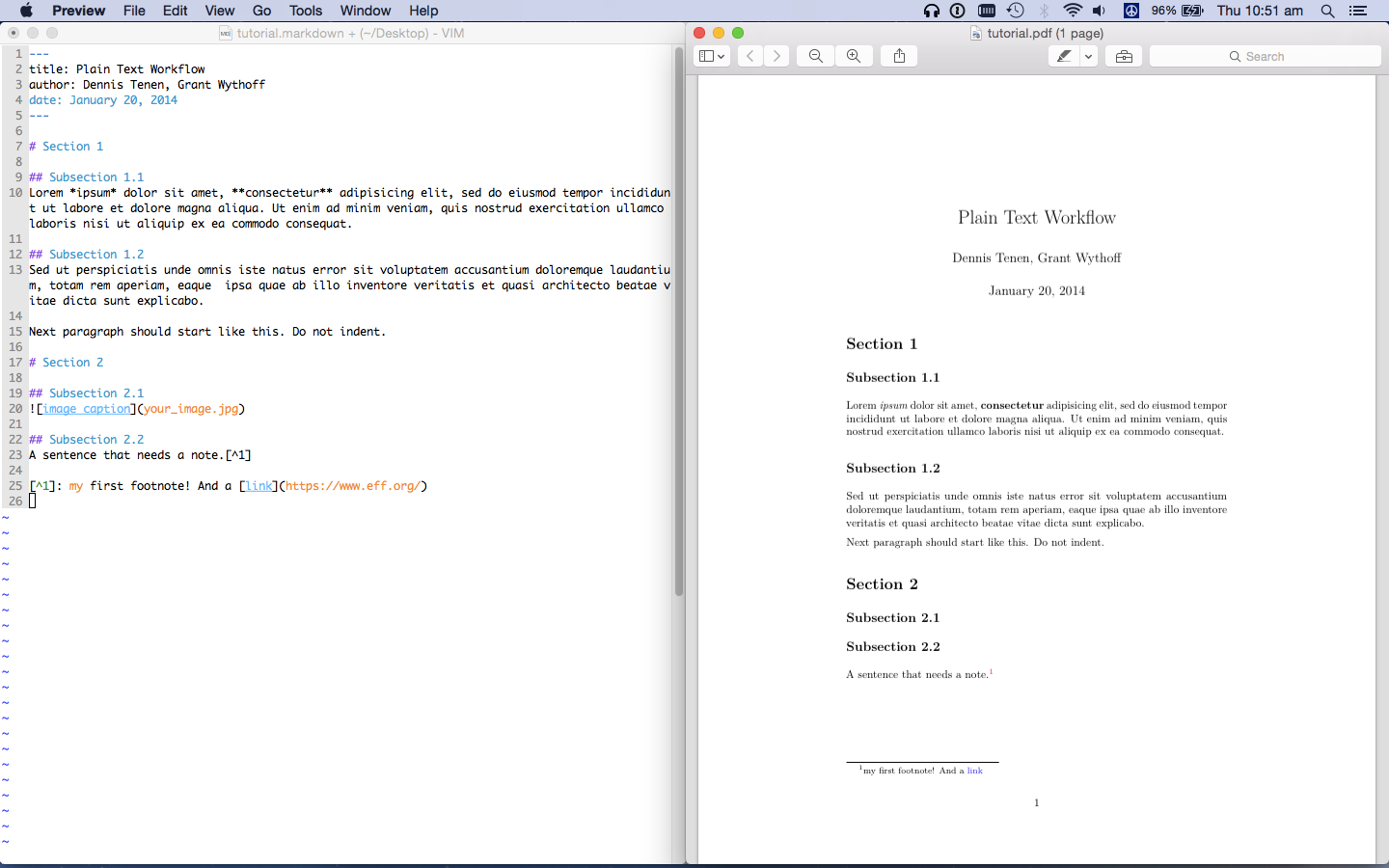The first post in this series can be found here:
Hybrid workflow how-to: introduction & editorial steps


- In this short video I give a demo of a script I've written that uses pandoc (to create documents that can.
- In this step we use pandoc to convert an edited markdown file as it would arrive from an editor into first HTML, and then to an EPUB.
- Introducing Markdown and Pandoc: Using Markup Language and Document Converter Thomas Mailund download Z-Library. Download books for free.


As part of the INC subgroup, we have been developing a workflow that allows a flexible production of different kinds of electronic outputs like EPUB, PDF, and book trailers from a sample collection of essays from the recently published Society of the Query Reader.
Pandoc -s -o doc.pdf doc.md. Pandoc is able to merge multiple Markdown files into a single PDF document. To generate a single PDF document out of two Markdown files you can use: pandoc -s -o doc.pdf part01.md part02.md. By default the page margins in the resulting PDF document are quite large. You can change this by passing a margin parameter.
In part one of this tutorial, we look at using the pandoc tool on the command line to convert a markdown source that has been edited by an editor into HTML and EPUB outputs. In addition, we will add metadata and use pandoc templates and a stylesheet to customize the output.
This tutorial is targeted for developers or people interested in creating automated workflows for producing EPUBs. It assumes basic familiarity with a commandline interface (such as the Terminal application on GNU/Linux or Mac OS X, or the command prompt in Windows). Introductions to the commandline such as the Designers guide to the OS X Command Prompt can be very useful if the commandline is still new to you.
Install pandoc
Instructions for installing pandoc on Mac, Windows, and Linux are given on the pandoc website.
Mac: From the download page, find the green button with a link that ends with “osx.pkg”. Download and install this.
Debian/Ubuntu: Pandoc is available from your package manager:
However, the version of pandoc is typically outdated. To compile the latest and greatest, follow the instructions on the pandoc website under “All platforms”. In a nutshell:
Prepare your workspace & tools
Unpack, checkout or copy the sample files from the github repository. Open the Terminal and use the cd command to enter the “part1” folder in the developer section of the how-to-tutorial files.
As we will be working with different kinds of code (both markdown and HTML output), it is quite important to have a good code editor to work with. A code editor (as opposed to programs like “Simple Text” or Microsoft Word) provides features like language-specific syntax coloring and helpful keyboard shortcuts for say adding comments. Many code editors exist from classical commandline editors like vi and emacs, to graphical editors like gedit and Sublime Text. Though not Free Software, Sublime Text is an excellent cross-platform code editor with many advanced features, which is free of charge to use (in Trial mode) indefinitely and a good example of the state of the art of contemporary code editors in terms of features and usability.
Use pandoc to convert a single markdown source file to HTML & EPUB
As you may have seen in Step 5 of the Hybrid Workflow Howto for Editors, you can use the pandoc program to convert from one file format to another (such as in that example from Word DOCX to Markdown). In this step we use pandoc to convert an edited markdown file as it would arrive from an editor into first HTML, and then to an EPUB.
Open the file Kylie-Jarett.md in your editor, it begins:
In the terminal type the following. Note that once you type the K of the filename you should be able to press the tab key to “auto-complete” the name of the file:
By default pandoc will attempt to guess the type of the input file based on the file extension. In this case the “.md” means that pandoc assumes Markdown input. By default pandoc produces HTML and prints it to the terminal rather than saving it in a file. To save it to a file, you can use pandoc’s -o option:
You can also explicitly state input and output types with pandoc’s –from and –to options. This can be useful if a filename misses a recognizable extension:
In general the order of the parameter doesn’t really matter, as long as the options precede their values, so the following would be the same:
Use a web browser to open the resulting file (test.html) and check the output. It should appear as formatted HTML. However there are likely some glitches in the text. This is because pandoc’s default HTML output is merely a fragment, and not a complete HTML document, and some information (such as the proper encoding of the text) is not included. If you open test.html in your editor, you see that the file begins:
Note that pandoc automatically assigns an id to the header. This is useful when linking. Next, run pandoc again, this time adding the –standalone (or -s) option:

If you reload test.html in the browser, you should see that the character gliches are corrected. If you look at test.html in your editor, you see it now begins:
Using Pandoc To Use
The output now contains a proper HTML doctype and head section with, among other things a character set, which tells the browser to interpret the text as encoded in the utf-8 standard (Browsers by default assume the latin-1 character set when a document doesn’t state it’s encoding which is why the characters were being misinterpreted in the fragment).
Add metadata to your document
In the HTML output in the previous step, the title tag in the document is left blank. Even though the title of the essay is in the document, it’s a level one header, pandoc doesn’t make any assumptions that that is a title. Pandoc supports adding “metadata” (data about the document itself).
Add the following to the first lines of the file “essays/Kylie_Jarrett.md”:
Now repeat the pandoc command to update the test output:
The resulting document now looks like this:
Pandoc detects the title and author settings in the metadata and automatically adds them to both the HTML header (as the title and a meta tag), as well as creating an h1 and h2 tag at the start of the document. The problem now is that the title and author’s name appears twice. It’s best to remove the title and author’s name form the body of the document.
Remove the original title & author lines from Kylie-Jarrett.md so that it looks like this:
And once again:
This should look better. In the next step we see how to use pandoc’s template feature to customize how the metadata is displayed in the output. Using metadata in this way is a useful way to create a more flexible source document that can produce different kinds of outputs and tailored to different contexts.
The format pandoc uses for metadata is called YAML. One important detail to note is that if a title includes a colon character (:), you need to put quotation marks around the title, as in:
To give multiple authors, you can use a list by using square brackets and separating names with commas, as in:
Using Pandoc To Measure
When converted to HTML produces:
Customize your output with a template and a stylesheet
So how did pandoc know what to do with the title and author in your metadata? It turns out that pandoc has a collection of standard templates, or for each output format, which it uses to produce its output.
To see pandoc’s template for producing HTML output, type the command:
The output (in part) shows:
In the template, you can see that pandoc provides some sophisticated tools like conditionals (if) and loops (for) to provide basic handling for optional elements and lists author names. To customize this standard template, make a copy of it named custom.html:
Open the custom.html and change the display of the title and author to:
You can also see in the template that pandoc provides a number of ways of adding custom stylesheets. The easiest is to use the –css option. So create a new file names “styles.css” with the following:
And now bring it all together with:
Produce an EPUB
Use Pandoc From R
You can easily produce an EPUB from a markdown source with pandoc by simply specifying an EPUB extension to the output file. Note that the –standalone option is implicit with an EPUB:
To specify custom CSS with an EPUB, use the –epub-stylesheet option:
Note that pandoc places an automatically generated table of contents as the last page, to move this to the front use the –table-of-contents option.
Using Pandoc To Find
Next time…
Using Pandoc
In part 2 of this tutorial, we will work on a script to compile a collection of essays into a single Reader EPUB.
